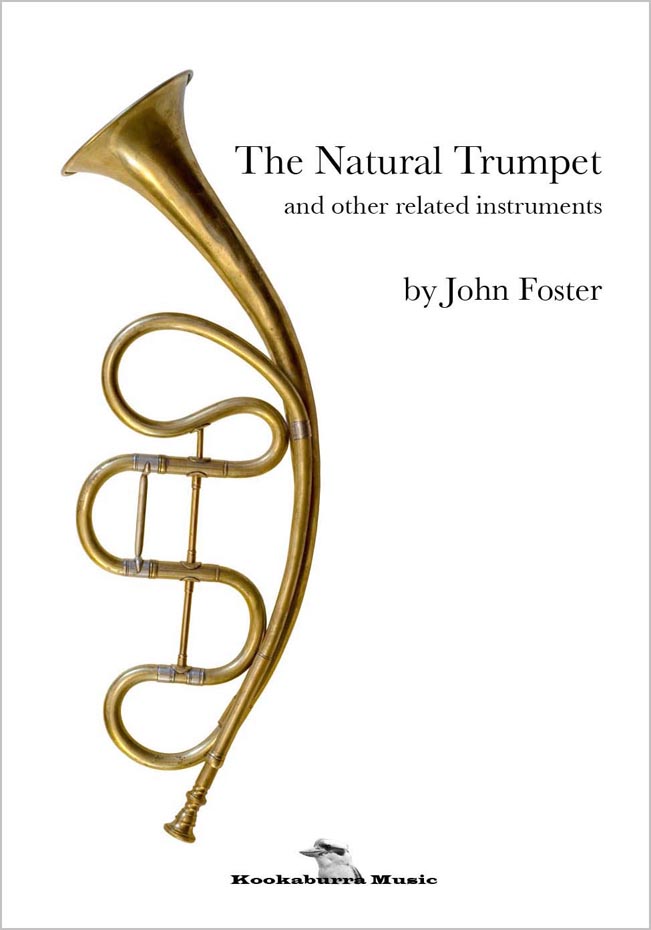
Foster, John. The Natural Trumpet and Other Related Instruments. Edited by Edward H. Tarr. Sydney: Kookaburra Music, 2010. 81 pages, 58 black and white photographs, ISMN 979-0720099-88-0. Click here for the publisher's site.
Many HBS readers will be familiar with the career of John Foster as a widely respected Baroque trumpeter. Foster lives in Sydney, Australia, but he has appeared in many international venues and is a consultant to the USA trumpet maker, Andrew Naumann. Although Foster’s generously illustrated book is titled The Natural Trumpet, much of the discussion of the book centers on the vented trumpet that has become the normal tool of the modern business Baroque trumpeter. Foster prefers the four-hole, long form model and reasons that it is easier to begin study on the four-hole model and then learn the three-hole model rather than to learn things the other way around. Fingering charts are provided for each type of vented instrument. The parts of the Baroque trumpet are also covered. The exercises that follow are in the mold of those found in the methods of Laird and Tarr with a section on trills and ornament studies that have practical value for those that are playing the vented instruments. The most practical advice in my view in the entire volume comes in a two-page section called “Approaching the Summit (Johann Sebastian Bach’s Brandenburg Concerto No. 2).” The bulleted points Foster offers here will serve a student well even if they never get to play the Brandenburg 2. The points he offers – learn the score, listen, set achievable goals, break work into small sections, practice fingerings separately, transpose to lower pitched instruments, spend time on difficult passages when you are fresh, select slow tempos, use a light fluid approach, rest – are the keys to practicing anything on a trumpet, natural or otherwise. This is sage advice from someone who has been there.
The book also includes fingering charts for the four-keyed trumpet and a chart for hand stopping the Demilune trumpet in F. Later in the method, there are pictures of Pless horns, bugles, post horns, flatt trumpets, tromba di tirasi, English slide trumpet and other related instruments from Foster’s collection. Short biographical sketches of important trumpeters such as Valentine Snow, John Shore, Pavel Vejvanovsky and Johann Heinisch are also included to provide inspiration. The volume concludes with a few orchestral excerpts, a listing of suggested repertoire and a bibliography.
This volume will be of greatest interest to those who appreciate John Foster’s considerable abilities on the modern vented trumpet. The book reflects Foster’s personality and interest in collecting and sharing his experiences as a player and introduces the student who has decided to invest in a vented Baroque trumpet. Meanwhile, players like Jean-François Madeuf are demonstrating daily that unvented natural trumpets can play everything that the vented instruments can play. Foster addresses this issue in a single sentence when he states “ . . . I would not be surprised if before long we see a far greater resurgence of performance using no vent holes” (page 12). The widespread success of those who are facing the challenge of going natural (without vents) deserves greater coverage in a volume such as this. What techniques best develop the old way of playing? What are the obstacles to the modern player who needs to double on historic brass? What practice techniques foster confidence and consistency? Perhaps we all need to address this issue individually to find the secrets of technique of the natural trumpet in both the present as well as the past. In any case, it is time to acknowledge the elephant in the room. There certainly are no easy answers to these questions or more people would be performing in the natural way by now. The Barclay/Seraphinoff trumpet making workshops, the careful study of performers who are mastering the original techniques, and daily diligence in personal practice are a start.
-- Ralph Dudgeon, SUNY Cortland



